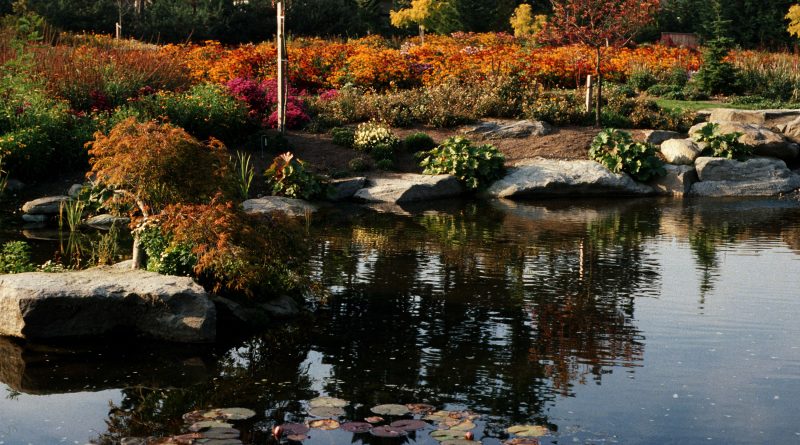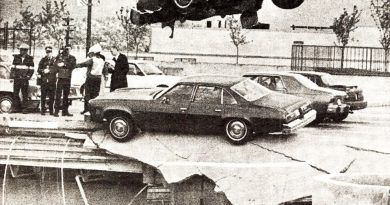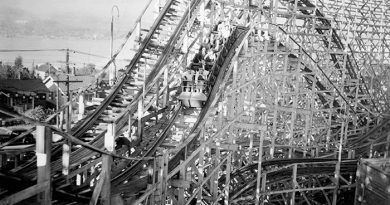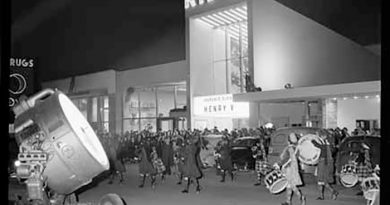1975
Above: Pond at VanDusen Botanical Garden which opened in 1975.
[Image: Vancouver City Archives AM1502-S1-2-: CVA 1502-7]
*****************************************
You’ll note that these years include events listed under “Also in . . .” These are events for which we don’t have a specific date. If YOU know the specific date of an event shown there, please notify us . . . and cite the source! Many thanks!
*****************************************
January 22 The Granville Mall was closed to all but transit, emergency and taxi traffic.
January 27 The last wall of the elegant old Birks Building at Georgia and Granville Streets, which opened for business November 8, 1913, came down to make way for the Vancouver Centre development. The ten-storey (plus mezzanine) white terra cotta-clad building was a local favorite, and its demolition infuriated many. Not long after its demolition Pierre Berton gave a talk to some heritage people in Winnipeg in which he said: “When I was a young reporter in Vancouver, I thought the Birks Building there was a pretty bad building, but it’s unique. A building covered in white tile, unique for that city. It’s gone!” We cite Berton’s remark here because it’s part of a much longer and really interesting talk on the subject of heritage conservation. See it at this website.
February 13 Arthur Laing died. See the August 27 item below.
April 8 Pink Floyd appeared at the PNE in Vancouver.
April 14 At 3 p.m. Vancouver Co-operative Radio CFRO-FM 102.7 signed on with community-based programming. The station was and is non-profit, community-based, and run by its members. (We also have an April 15 start.) There is an excellent article by Sabrina Abdul here that describes the atmosphere at the station and gives a good brief history.
May 21 The Australian cricket team, at the time probably the best in the world, stopped on their way to England to play in the World Cup, and played British Columbia at Brockton Point.
June 9 Three prisoners at the BC Penitentiary who were about to be returned to solitary confinement took 15 hostages. The standoff with prison officials would last 41 hours and end June 11 with an emergency response team storming the hostage takers. During the raid one of the guards accidentally shot and killed one of the hostages, classification officer Mary Steinhauser, 32. Ironically she had been working at implementing courses for prisoners in solitary. Christian Bruyére wrote a 1978 play, Walls, based on the incident. It was made into a movie in 1984.
June 21 BC Rail’s “Royal Hudson” train began its hugely popular run to Squamish.
August 27 The Arthur Laing Bridge, (originally called Hudson Street Bridge), designed to improve traffic flow to and from the airport, opened. Prime Minister Trudeau had announced in September 1974 that the bridge would be named for him, but Laing was, sadly, unable to attend the event. He died February 13, just seven months earlier, aged 70. The south end of the bridge is near Eburne, in Richmond, where Laing was born September 9, 1904. There is a good brief bio of him here.
August 30 VanDusen Botanical Garden opened. The Garden’s attractive website has a page on its history that says: “In 1910, this site was an isolated acreage of stumps and bush. It was owned by the Canadian Pacific Railway and was leased by the Shaughnessy Golf Club from 1911 until 1960 when the golf club moved to a new location. The railway proposed a subdivision, but was opposed by many citizens. In 1966, the VanDusen Botanical Garden Association was formed to assist the Vancouver Park Board with saving the site. This effort was successful and the land was purchased with shared funding from the City of Vancouver, the Government of British Columbia and the Vancouver Foundation with a donation by W. J. VanDusen, after whom the Garden was named. Development started in 1971 and VanDusen Botanical Garden officially opened to the public on August 30, 1975.”
Eleven pieces of stone sculpture were created over the summer during the International Stone Sculpture Symposium at the garden. You can see them here.
The main page of the Garden is here.
September 6 The Resort Municipality of Whistler was established by the provincial legislature. The unique designation (“resort” municipality) took account of the special problems faced by the developing resort.
September 13 Architect C.B.K. Van Norman died in Vancouver, aged 68. “Charles Burwell Kerrins Van Norman,” writes Constance Brissenden, “was born March 20, 1907 in Meaford, Ont. He graduated in architecture at the University of Manitoba in 1927, came to Vancouver in 1928. From 1930, his work included mansions for General A.D. McRae, H.R. MacMillan and F. Ronald Graham. He designed Customs House, the Burrard Building, the Vancouver Maritime Museum and Eagle Crest Lodge at Qualicum Beach. Van Norman specialized in post-WWII schools and pre-fab homes. He was a design consultant for Royal Centre (Burrard and Georgia), and designed many of Park Royal’s stores. After convincing the city to allow wider balconies than had been previously permitted, he won the Canadian Housing Design Council’s Centennial Award for Beach Towers (1600 Beach).”
September 24 Poet Pat Lowther, born Patricia Louise Tinmuth in Vancouver July 29, 1935, was murdered by her husband. Her body was discovered in Furry Creek, near Squamish. Roy Lowther would be convicted of her murder in June 1977. He died in prison in 1985. A bio devoted to her reads: “The loss to her family and friends is immeasurable, and the loss to Canadian literature was widely acknowledged. In The Dictionary of Canadian Biographies Hilda Thomas suggests that Pat Lowther’s death ‘robbed Canadian poetry of one of its most vital and visionary poets.’ In 1980, the League of Canadian Poets established the Pat Lowther Award , an annual prize to honor a new book by a Canadian woman poet.”
Her most well-known work, A Stone Diary, would be published posthumously in 1977 by Oxford University Press.
September 25 The Ubyssey, the three-times-a-week paper for students at UBC, published a sort of interview with “Ace” Aasen, well-known locally as the “Mayor” of Gastown. Ace, who was quite pleased to accept a drink from you at any time, strolled around the Gastown streets in a somewhat tattered top hat, sporting a cane and passing along his thoughts on life. In this Ubyssey interview, which at times approached coherence, he gave us his thoughts on pollution: IT WILL DISAPPEAR.
October 7 Moshe Dayan, Israel’s former defence minister, was speaking to an audience at the University of British Columbia. “The Middle East is still the powder-keg of the world,” he said. A chair-throwing battle broke out between political factions in the audience, while anti-Zionist demonstrators stamped and chanted outside. Dayan, whose dramatic black eye-patch and gleaming baldness made him one of the most familiar faces of the tension-filled ’70s, dealt with the disruption “in the manner,” one reporter wrote, “that helped make him a general.”“SIT DOWN AND BE QUIET,” he roared. And everyone did.
November 3 The Greater Vancouver Library Federation was formed. In 1994 it will become InterLINK which, among other things: facilitates open access to 17 member libraries for all residents and provides delivery service; coordinates Audiobook services; supports Interlibrary Loan and acts as an advocate for libraries.
November 23 The last movie was shown at the Orpheum Theatre. Ivan Ackery, longtime manager of the theatre, tells the story in his autobiography Fifty Years on Theatre Row: “On Sunday, November 23, 1975 projectionist Bill Field pressed the button that drew the final curtain on the Orpheum Theatre’s last picture show. Orpheum manager Ted Bielby wanted to show the Oscar-winning nostalgia film The Last Picture Show, but he had to run Return to Macon County instead. Impresario Hugh Pickett attended that last movie and held a closing party for Ted and his staff.” What makes that item doubly interesting is that Hugh Pickett had been in the audience for the first movie at the Orpheum November 7, 1927. He was 14.
December 23 Bill Bennett, who had defeated Dave Barrett, took office as BC’s 27th premier. He was the son of the 25th premier, W.A.C. Bennett. Bill Bennett was born in Kelowna, April 14, 1932. He would serve to August 6, 1986.
December 26 A runaway logging barge, driven by a westerly gale, carried away a 116- metre span of the Fraser River Swing Bridge at New Westminster. Fortunately, Burlington Northern had drawings for a modern 114-metre span recently built at Spokane. This speeded the repair and reopening of this busy but obscure railway bridge.
December 30 Sue Baptie became Vancouver’s City Archivist at the City of Vancouver Archives. She would hold that post with distinction until 1993, a total of 18 years.
December 31 BC Hydro began an inaugural run of two Flyer E800 trolleys, with company officials as passengers. By the spring of 1976, the rest of the Flyer E800s would arrive.
Also December 31 The Vancouver nightclub The Penthouse was closed by the vice squad.
Also in 1975
Construction began at Kingsway and Boundary on B.C. Tel headquarters, 3777 Kingsway, a building nicknamed The Boot because of its tapering design. Architects were Musson Cattell.
Mrs. Otto Koerner turned the sod near Building 14 at Vanier Park to mark the start of construction of the new Community Music School home. It will open in May 1976.
In 1969 Maria Lewis formed the Maria Lewis Ballet Ensemble in Vancouver. This year the former board of directors of the defunct Ballet Horizons approached her and asked her to form a new company to be called the Pacific Ballet Theatre. She would direct it until 1980 when she was succeeded by Renald Rabu. Today, the company is called Ballet British Columbia.
B.C. Heritage Day celebrations included the 3rd annual grand prix bike races in Gastown and the 1875 Burrard Inlet Dominion Day Festival at the Centennial Museum.
Cypress Provincial Park was created in West Vancouver. At its creation, the park covered just over 2,100 hectares. Today, it’s 3,012 hectares. “Bounded on the west by Howe Sound,” says its website, “on the north and east by the ridgetops of Mount Strachan and Hollyburn Mountain and to the south by West Vancouver, Cypress sits like a ship’s crowsnest high above Vancouver.”
Dr. Louis Miranda, born in 1892, was one of the foremost experts on Squamish culture and language. Miranda, a former Squamish chief, began his work with the Dutch ethnographer Aert Kuipers in creating a written language for the Squamish Nation. Miranda would receive the Honorary Degree of Doctor of Laws from SFU in 1981 for that initiative.
A major sewage plant was built on Annacis Island, handling waste from Burnaby, Surrey, Coquitlam, Port Moody, Delta and parts of Richmond. At first it offered only primary treatment. It would be upgraded in 1999 to provide secondary treatment. The treated effluent is discharged into the Fraser River.
The Great Northern Railway—now the Burlington Northern (BNR)—withdrew passenger service from White Rock.
The IBM Tower was erected at 701 W. Georgia.
The Strand Theatre on the south side of Georgia Street just east of Granville came down to make way for Vancouver Centre.
Lutz Haufschild installed his fibreglass Wind-Blown Mounds at West 13th Avenue at Fir Street. Says arts writer Elizabeth Godley, “These yellow mounds are all but obscured by greenery.”
Elizabeth Godley also wrote on these items:
Integrated Plane, a corten steel sculpture by Barry Cogswell, was installed at North Vancouver City Hall (upper plaza), 141 West 14th Street. Purchased for $4,800 by the Community Arts Council and the City of North Vancouver, this piece makes reference to the mountains, sea and forest.
Tapestry, by Setsuko Piroche, was installed in the North Vancouver library at 121 West 14th Street.
A sculpture titled Swedish Fountain was installed at VanDusen Botanical Gardens. The $50,000 cast bronze piece, by Per Nilsson-Ost, was donated by the Swedish community, led by Vancouver real-estate magnate Edwin Albert Alm. Eight bronze panels depict Swedish involvement in B.C. industry.
Waterfall, designed by architect Peter Cardew, then working for Rhone & Iredale, was installed at 1500 West Georgia.
The Greater Vancouver Regional District’s “Livable Region Plan” was introduced.
With the U.S. pulling out of Vietnam, the first Vietnamese refugees began arriving in Vancouver.
Douglas T. Kenny became the seventh president of UBC, succeeding Walter Gage.
St. Paul’s Hospital opened the first Drug and Poison Information Centre (DPIC) in Canada.
Gil Evans was hired as coordinator at the Community Information Centre.
A steel-and-plastic shield, strong enough to stop a bullet from a .38-calibre revolver, was imported from New York by businessman Winston Malt and used in a Yellow cab driven by John Adam.
Fred Kaiser founded Alpha Technologies. Today, Alpha employs more than 2,000 people around the world. To quote their website, “Alpha Technologies is a world leading developer of broadband, data communication, AC UPS, commercial, and industrial powering systems. Together with a broad range of products, Alpha Technologies supports a global customer base with comprehensive installation and maintenance services.” In 2005 Fred Kaiser will buy Boundary Bay Airport.
Dr. James McFarlane founded International Submarine Engineering Ltd. ISE, in Port Coquitlam, is, to quite its website, “a world leader in the design and development of Remotely Operated Vehicles (ROVs), Autonomous Underwater Vehicles (AUVs), and robotic manipulator systems for land, subsea and space training applications.”
The movie Russian Roulette was released. It was based on a 1974 novel, Kosygin is Coming, by Vancouver Sun journalist Tom Ardies, who also wrote the screenplay. Says the movie site www.imdb.com: “An RCMP officer is ordered to discreetly take a Russian immigrant into custody in advance of a state visit by the Soviet premier. When his prisoner is kidnapped, the officer is drawn into a complicated assassination scheme.”
The movie’s climax takes place atop the Hotel Vancouver’s steep green copper roof. One imdb site visitor commented: “George Segal is well-cast and looks genuinely scared in the vertiginous rooftop shootout.” He was genuinely scared, as anyone would be clambering around the roof of the Hotel Vancouver! No special effects.
See more on Tom Ardies at this site.
Other locally-made movies (annotations here by Michael Walsh) included:
Journey Into Fear (directed by Daniel Mann) Sam Waterston, Yvette Mimieux, Vincent Price, Shelley Winters, Zero Mostel and Donald Pleasence were among the stars assembled for a remake of the 1942 suspense thriller, with Vancouver playing various Mediterranean ports of call.
Dogpound Shuffle (aka Spot, directed by Jeffrey Bloom) A pair of bickering buskers (Ron Moody and David Soul) work Davie Street for enough change to free their beloved dancing dog (Scruffy) from the pound.
The Supreme Kid (directed by Peter Bryant) Anticipating Generation X, SFU Film Workshop graduate Bryant sent three young drifters (Frank Moore, Jim Henshaw and Don Granberry) on an ill-fated search for adventure in and out of town.
The Vancouver Canucks win their first division title. Much credit goes to goalie Gary “Suitcase” Smith, winning 32 games with six shutouts.
James Keeling Sr., the proprietor of Orangeville Raceway and other businesses in Ontario, struck a deal with the Surrey Fair Board and Cloverdale Raceway went into business.
The Gordon and Mary Russell Seal Pool opened in the Vancouver Public Aquarium
A woman named Charlie Galbraith had an idea that turned into the non-profit British Columbia Country Music Association. The BCCMA was conceived as an awards vehicle for local country music and today holds an annual conference and awards show every June.
Vancouver’s second firehall (at 280 East Cordova) began answering alarms in 1906. This year the hall closed, the last fire truck drove away, and a group called Actor’s Workshop attempted to turn it into a theatre before folding. But in 1982 a second attempt will be successful. More information on the Firehall Theatre will be available when we get to that year!
Impresario David Y.H. Lui opened his own venue, the David Y.H. Lui Theatre. Unfortunately, it would close in 1979.
Press Gang began publishing books. To quote the website of Collections Canada, an initiative of Library and Archives Canada, “Press Gang began as a left-wing printing co-operative in Vancouver in 1970. In 1974 it became an all-women collective, offering printing services to local community and women’s groups which had an anti-capitalist perspective and promoted the liberation of women. In 1975, with the publication of its first book Women look at psychology, Press Gang expanded from printing into publishing.” That web site has much more on the company’s later and current activities. They have published more than 50 books, virtually all of which are still in print.
Vancouver’s Robert Bringhurst received the Macmillan Prize for Poetry. See a lengthy and very interesting appreciation of this prolific writer here.
Grand Prairie, Alberta-born (1940) Helen Potrebenko fictionalized the struggle to earn a living of a female cabbie in Vancouver with the novel Taxi. See this site.
Donald Gutstein’s book Vancouver Ltd. was published. It was an economic study of Vancouver, with special reference to CPR influence. See this site.
The new Vanterm container terminal went into operation. Today, the enlarged facility has a capacity of 600,000 TEUs. (A “TEU” is a standard “Twenty Foot Equivalent Unit” steel ocean-shipping container. Hence, containers are called “TEUs.”)
Musician Harry Adaskin and mountaineer Phyllis Munday received the Order of Canada.
Baltimore-born (March 28, 1921) Alvin Balkind became the chief curator at the Vancouver Art Gallery. He will hold the post to 1978.
The Native Sons of B.C. named Ben Wosk Good Citizen of the Year.
Doreen Braverman opened the first Flag Shop. They believe they were the first specialty flag retailer in the world. There are 13 Flag Shops today, all the way across to Dartmouth, Nova Scotia. Their product-line has broadened over the years to include custom banners, a full line of flag hardware, pins, crests, decals—anything flag-related. See this site.
At the behest of Attorney General Alex Macdonald Hugh Keenleyside undertook a study and published The Fire Fighting Services in British Columbia. He came down hard on the province’s record. We found a passage from Hansard for May 4, 1976 in which NDP MLA Bob Skelly said: “In the 10 years from 1963 to 1972, we lost 94.8 lives, on the average, to fire, which is 75 per cent above the national rate. The per capita financial loss to fire in B.C. was $12.33, some 751 per cent above the national rate for Canada. Residential fires were 88 per cent above the average rate for all the other provinces. Per capita losses through manufacturing plants were 50 per cent above the rate for the rest of Canada. For institutions and buildings of public assembly, again British Columbia’s loss was $1.03 per capita. The average for Canada was 55 cents. So our record, as far as fire protection in this province, has been the worst in Canada – worse than any other province, worse than the United States which has the worst record in the industrialized world, and it’s been deteriorating, according to Mr. Keenleyside’s statistics, over the year since the fire marshal’s office was established.”
The Port Moody Curling Club was founded, with Norm Sherling as its first president. Today there are more than 400 members. See this website.
Walter and Marianne Koerner made a gift of their extensive Northwest Coast art collection to UBC’s Museum of Anthropology, which would move to its splendid present location in 1976. This donation helped substantially in acquiring financial commitments to the museum from the federal government and UBC itself.




